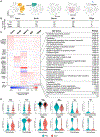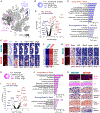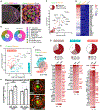Multi-transcriptomics reveals brain cellular responses to peripheral infection in Alzheimer's disease model mice
- PMID: 37436901
- PMCID: PMC10530196
- DOI: 10.1016/j.celrep.2023.112785
Multi-transcriptomics reveals brain cellular responses to peripheral infection in Alzheimer's disease model mice
Abstract
Peripheral inflammation has been linked to various neurodegenerative disorders, including Alzheimer's disease (AD). Here we perform bulk, single-cell, and spatial transcriptomics in APP/PS1 mice intranasally exposed to Staphylococcus aureus to determine how low-grade peripheral infection affects brain transcriptomics and AD-like pathology. Chronic exposure led to increased amyloid plaque burden and plaque-associated microglia, significantly affecting the transcription of brain barrier-associated cells, which resulted in barrier leakage. We reveal cell-type- and spatial-specific transcriptional changes related to brain barrier function and neuroinflammation during the acute infection. Both acute and chronic exposure led to brain macrophage-associated responses and detrimental effects in neuronal transcriptomics. Finally, we identify unique transcriptional responses at the amyloid plaque niches following acute infection characterized by higher disease-associated microglia gene expression and a larger effect on astrocytic or macrophage-associated genes, which could facilitate amyloid and related pathologies. Our findings provide important insights into the mechanisms linking peripheral inflammation to AD pathology.
Keywords: Alzheimer’s disease; CP: Immunology; CP: Neuroscience; amyloid plaques; blood-brain barrier; blood-cerebrospinal fluid barrier; microglia barrier; peripheral inflammation.
Copyright © 2023 The Authors. Published by Elsevier Inc. All rights reserved.
Conflict of interest statement
Declaration of interests C.S.-G. has an additional affiliation at Biotechnology Center, Federal University of Rio Grande do Sul, Porto Alegre, RS 91501-970, Brazil.
Figures







Similar articles
-
Novel App knock-in mouse model shows key features of amyloid pathology and reveals profound metabolic dysregulation of microglia.Mol Neurodegener. 2022 Jun 11;17(1):41. doi: 10.1186/s13024-022-00547-7. Mol Neurodegener. 2022. PMID: 35690868 Free PMC article.
-
Fibrillar Aβ triggers microglial proteome alterations and dysfunction in Alzheimer mouse models.Elife. 2020 Jun 8;9:e54083. doi: 10.7554/eLife.54083. Elife. 2020. PMID: 32510331 Free PMC article.
-
Microglia limit the expansion of β-amyloid plaques in a mouse model of Alzheimer's disease.Mol Neurodegener. 2017 Jun 12;12(1):47. doi: 10.1186/s13024-017-0188-6. Mol Neurodegener. 2017. PMID: 28606182 Free PMC article.
-
Microglia in Alzheimer's Disease.Curr Alzheimer Res. 2020;17(1):29-43. doi: 10.2174/1567205017666200212155234. Curr Alzheimer Res. 2020. PMID: 32048973 Review.
-
Effects of CX3CR1 and Fractalkine Chemokines in Amyloid Beta Clearance and p-Tau Accumulation in Alzheimer's Disease (AD) Rodent Models: Is Fractalkine a Systemic Biomarker for AD?Curr Alzheimer Res. 2016;13(4):403-12. doi: 10.2174/1567205013666151116125714. Curr Alzheimer Res. 2016. PMID: 26567742 Review.
Cited by
-
Spatial-Omics Methods and Applications.Methods Mol Biol. 2025;2880:101-146. doi: 10.1007/978-1-0716-4276-4_5. Methods Mol Biol. 2025. PMID: 39900756 Review.
-
Transcriptomic Response to Neuromuscular Electrical Stimulation in Muscle, Brain, and Plasma EVs in WT and Klotho-Deficient Mice.Int J Mol Sci. 2025 Aug 14;26(16):7849. doi: 10.3390/ijms26167849. Int J Mol Sci. 2025. PMID: 40869172 Free PMC article.
-
Neuroinflammation in Alzheimer's Disease: A Potential Role of Nose-Picking in Pathogen Entry via the Olfactory System?Biomolecules. 2023 Oct 24;13(11):1568. doi: 10.3390/biom13111568. Biomolecules. 2023. PMID: 38002250 Free PMC article. Review.
-
Elevated C-Reactive Protein in Older Men With Chronic Pain: Association With Plasma Amyloid Levels and Hippocampal Volume.J Gerontol A Biol Sci Med Sci. 2024 Nov 1;79(11):glae206. doi: 10.1093/gerona/glae206. J Gerontol A Biol Sci Med Sci. 2024. PMID: 39169831 Free PMC article.
-
Microglia depletion/repopulation does not affect light-induced retinal degeneration in mice.Front Immunol. 2024 Jan 15;14:1345382. doi: 10.3389/fimmu.2023.1345382. eCollection 2023. Front Immunol. 2024. PMID: 38288111 Free PMC article.
References
Publication types
MeSH terms
Substances
Grants and funding
LinkOut - more resources
Full Text Sources
Medical
Molecular Biology Databases
Miscellaneous

